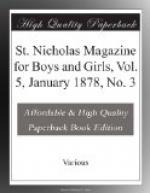The birds are not compelled to face the wind while they are sailing, but by changing the position of the wings a little they can go in whatever direction they wish, much as a boy changes his direction in skating by leaning a little to one side or the other. Some birds are very skillful at this kind of sailing, and can even remain stationary in the air for some minutes when there is a strong wind; and they do this without flapping their wings at all. It is a difficult thing to do, and no birds except the most skillful flyers can manage it. Some hawks can do it, and gulls and terns may often be seen practicing it when a gale of wind is blowing, and they seem to take great delight in their power of flight.
Of all birds the albatross is the most skillful in the art of sailing in the air. It is a large sea-bird, about the size of a swan, and has very long and powerful wings. It lives far out upon the open ocean, hundreds of miles from land, and spends nearly all of its life in the air, very seldom alighting upon the water. It flies almost entirely by the aid of the wind, and sometimes does not flap its wings for an hour at a time. Albatrosses often follow a ship clear across the ocean, or, rather, they keep company with the ship, for as they are able to fly one hundred miles an hour with ease, the rate at which a ship travels is much too slow for them; so they make long journeys ahead and behind, like a dog taking a walk with his master, returning occasionally to the ship to pick up any food which may have been thrown overboard.
NANCY CHIME.
BY S. SMITH.
[Illustration]
Untarnished by the breath of fame,
Untouched by prose or rhyme,
The world has never heard that name,—
The name of Nancy Chime.
Domestic, friend, and monitor,
She served us long and well;
Not many “helps” could equal
her,
And none, perhaps, excel.
No evil lurked within her breast;
Her face was always bright;
Her trusty hands, scarce needing rest,
Were busy day and night.
Her voice was sweet as voice of birds
That to each other call;
And when she spoke, her striking words
Were listened to by all.
E’en Baby Bunting—darling
boy,
The happiest of his race—
Would clap his little hands with joy,
And look up in her face.




